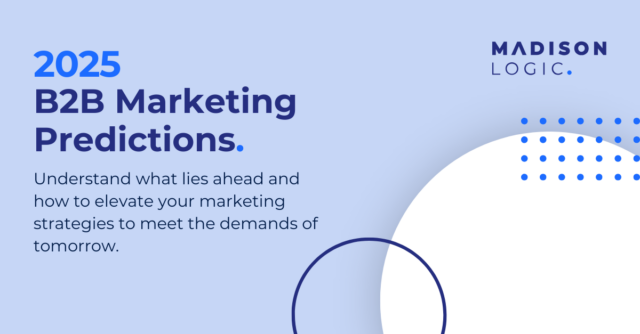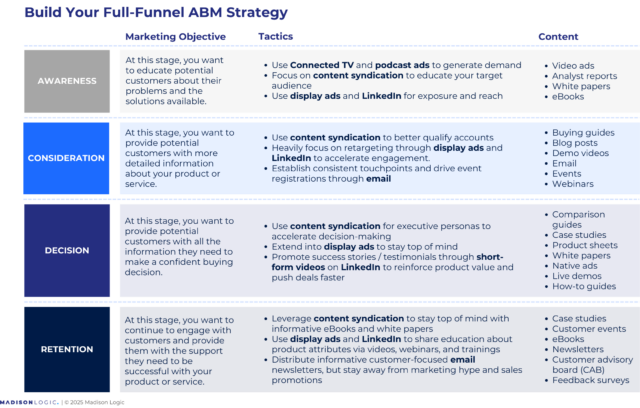
You’ve done everything right to set up your account-based marketing campaign—built a solid target account list, launched with the right content on the right channels, and established clear goals and KPIs to track success. But achieving real, sustained success with ABM goes beyond the initial setup.
The next step is optimizing and adapting your strategy to unlock even greater impact. Whether you want to break into new markets, target net-new logos, or sharpen your competitive edge, here are five ways to refine your approach and maximize results to take your ABM strategy to the next level.
Remove Your Data Silos with a Unified ABM Platform
A successful ABM strategy thrives on seamless coordination between marketing and sales teams, but fragmented data about your key accounts can hinder your efforts. It’s not an uncommon problem and the one most recognized by marketers when evaluating their campaign success with data—65% of B2B marketers citing that silos hurt campaign effectiveness and clarity.
The good news is that investing in a unified ABM platform (like Madison Logic) helps remove these silos by centralizing account insights and engagement data in a single source of truth. With a centralized system, both sales and marketing teams can access the same real-time information, eliminating discrepancies and ensuring decisions like building ideal customer profiles (ICPs) or creating a lead nurturing path are based on accurate, shared data. Integrating an ABM platform with your CRM and campaign management tools, for instance, enables dynamic reporting, enhances account segmentation, and gives a clearer view of engagement across your target accounts.
Beyond operational efficiency, a unified ABM platform also fosters data-driven collaboration. Shared dashboards encourage transparency, aligning marketing and sales on goals, ABM KPIs, tracking progress, and refining strategies together. By breaking down data silos, you can elevate your ABM approach—enabling more precise targeting, personalized messaging, and the flexibility to adapt to shifting market dynamics based on data-driven collaboration.
Inform Teams About Intent Signals Across Lead and Customer Accounts
Understanding when and why an account is showing interest is key to making ABM more effective. By tracking intent signals across both prospect and customer accounts, marketing and sales teams can identify opportunities to engage prospects at the right moment for any use case, be it a new account conversion or customer expansion opportunity.
Intent data gives your marketing and sales teams a competitive edge by revealing real-time opportunities based on buyer behavior. Instead of relying on guesswork, teams can engage with prospects and customers at the right moment, with messaging that directly aligns with their interests and needs to accelerate the sales cycle.
For example, if a prospect from a high-value account starts consuming multiple pieces of relevant content related to a specific solution—such as whitepapers, case studies, or product comparison pages—it signals strong interest. You can use this data to serve them targeted ads or nurture them with relevant emails, while sales can reach out with tailored messaging addressing their specific pain points to increase deal sizes and acceleration opportunity to closed-won conversion rates.
For existing customers, intent signals can uncover upsell and cross-sell opportunities. If a customer who initially purchased a basic software package begins researching advanced features or integrations, it indicates a need for expansion. Your sales teams can proactively offer premium add-ons, while you highlight relevant success stories or ROI calculators to reinforce the value of an upgrade with inbound marketing.
When your marketing and sales teams have shared visibility into intent insights, you can align your efforts to prioritize high-interest accounts, refine messaging in marketing campaigns, and accelerate pipeline growth. By making intent data a core part of your ABM strategy, you create more meaningful engagements that drive stronger results.
Explore and Incorporate Emerging Marketing Channels
ABM campaigns have long relied on familiar channels like content syndication, display ads, and LinkedIn to engage target accounts wherever they may be. While these channels remain effective, new channels are rapidly emerging due to shifting trends and external factors. New privacy regulations and the decline of third-party cookies are pushing ABM strategies beyond traditional digital channels. Marketers are now leveraging connected TV (CTV) for highly targeted video ads, non-traditional B2B social media apps like TikTok for interactive engagement, podcasts for thought leadership and niche audience reach, and putting a greater emphasis on in-person events to foster deeper, high-value connections with decision-makers. To stay ahead of the competition and achieve more with ABM, you must explore and incorporate these emerging channels into their plans.
To successfully integrate these emerging channels, consider how each one complements your existing efforts and strengthens engagement with your target accounts.
- Connected TV (CTV): Use CTV ads to reinforce your message with highly targeted video content. If a buying committee has engaged with your website or content in the early-stages, retarget them with CTV ads featuring customer success stories or product demos to keep your brand top of mind.
- TikTok & Other Social Video Platforms: While not a go-to for B2B, platforms like TikTok can humanize your brand. Short, educational videos, testimonial videos, or behind-the-scenes content featuring industry insights can help build more trust in the middle stages of the buying journey.
- Podcasts: Create concise, high-impact podcast ads that align with your broader messaging. Use storytelling, problem-solving, or thought leadership to deliver value and ensure your ad feels relevant and compelling.
- In-Person Events: Digital fatigue makes real-world connections more valuable than ever. Use account data to identify key prospects and ensure personalized follow-ups post-event, integrating insights from conversations into your broader ABM strategy.
The key to success is alignment—ensure these channels are part of your broader ABM orchestration, reinforcing messaging and engagement rather than operating in silos. By thoughtfully incorporating new channels, you expand your ABM reach while maintaining precision and personalization. As a best practice to figure out which channels work best, start with pilot strategies and programs before making larger investments. Testing allows teams to assess performance, fine-tune strategies, and determine the best fit within the ABM funnel.
Free Up Resources with Marketing Automation and Artificial Intelligence
Marketing automation and generative AI are game changers for ABM, freeing up valuable time and resources across marketing, sales, and customer success teams. By automating routine tasks, you can shift your focus from manual execution to strategic optimization—ensuring you engage the right accounts at the right time.
Automation streamlines key processes like triggering emails based on lead activity, sending real-time alerts to sales reps when a high-value account takes action in the sales funnel, and collecting data to determine intent. These efficiencies help both teams stay proactive rather than reactive, allowing you to refine messaging and optimize outreach as accounts move through the funnel.
AI further enhances this process by identifying patterns in customer behavior and assisting in the creation of personalized content, such as sales outreach emails or targeted campaigns for specific accounts. While human oversight remains essential—especially in reviewing AI-generated content—leveraging AI ensures outreach is timely, relevant, and aligned with what prospects and customers care about most.
By embracing automation and AI, ABM teams can work smarter, not harder—reducing manual workloads while improving engagement, responsiveness, and overall campaign performance.
Stay Ahead with Continuous Learning
The B2B landscape is constantly evolving—buying groups are expanding, purchase decisions are becoming more complex, and new technologies are reshaping how marketers engage accounts. To maintain a competitive edge and take ABM to the next level, continuous learning is essential. Keeping up with industry trends, emerging strategies, and evolving best practices ensures that your ABM approach remains effective and adaptable.
Ongoing training and certification programs provide more than just surface-level knowledge—they help build a foundation that goes beyond traditional ABM, enabling you to adapt to evolving trends and technologies. To take your strategy to the next level, look for certifications in ABM orchestration, intent data analysis, and AI-driven personalization. Participate in workshops on key subjects that achieve more success in ABM, like multi-channel engagement, CTV advertising, and emerging B2B social media strategies. Stay ahead with webinars and courses on first-party data strategies, revenue-based measurement, and sales-marketing alignment best practices. This continued education not only deepens your expertise but also empowers you to innovate, optimize, and drive greater success in your ABM programs.
Beyond events and certifications, staying informed through ongoing industry engagement is key to advancing your ABM strategy. Subscribing to ABM-focused newsletters, industry blogs, and research reports ensures you’re always up to date on the latest trends and best practices. Joining online forums and LinkedIn groups connects you with peers and thought leaders, offering valuable insights and real-world strategies. Engaging in ABM communities, Slack groups, and peer networking roundtables allows for knowledge sharing and collaboration, helping you refine your approach and stay ahead of emerging challenges.
By investing in continuous learning, you empower yourself and your team to stay ahead of industry shifts, drive innovation, and refine ABM strategies that deliver lasting success.
Adapt and Strive for More in Your ABM Strategy with Help from Madison Logic
While these are just a few tips on leveling up your ABM game, we’ve got more insights to help you apply all your ABM know-how to your most pressing objectives. Our comprehensive blueprints outline what you need to bridge the gap between simply activating a campaign and setting it up for success from the start:
- Convert to Conversations Blueprint: How to Turn Leads into Sales Meetings: Some leads need more time and information before engaging with your sales team. This blueprint shows how to activate ABM, offering the attention and personalization necessary to build trust and prompt action.
- Customer Expansion: ABM for Cross-Selling and Upselling Blueprint: Marketing doesn’t stop after a deal; retention is key to keeping customers. This blueprint helps you adjust your ABM strategy to expand and retain top customers by providing the attention and personalization needed to encourage further investment in your brand.
- Winning the Battle: Leveraging ABM for a Competitive Edge Blueprint: Ensure your target companies have you on their shortlist to avoid losing them to competitors. This blueprint shows how to use ABM in a competitive displacement strategy to outpace competitors from Day 1, letting you focus on growing your customer base.
- New Horizons: Navigating New Market Entry with ABM Blueprint: Entering a new market or launching a product? Build brand awareness to boost recognition and drive revenue. This blueprint shows how to use ABM for market entry, increasing engagement and opening doors for bigger deals and growth.
It’s not magic, its logic that will achieve more success with your ABM strategy. When you partner with us, you get the power of ML Insights, our proprietary intent data signals to cut through the noise and reveals your best accounts, the four channels you need to activate your content strategy where your accounts are, and the ML Platform to pull together the key campaign insights and metrics you need to make optimizations for greater revenue growth and higher ROI.
If you’re ready to do ABM the right way, request a demo to see it all in action.




